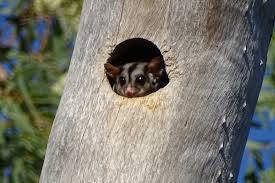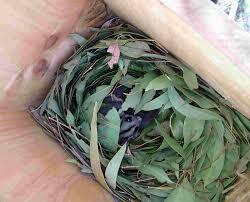Sleeping Arrangements

Sugar Gliders living wild in their native habitat, nest high in tree hollows. This is through all our four seasons and the various temperatures and weather conditions which come with them. Like any animal living in captivity, Sugar Gliders need to be provided with shelter that is sufficient to protect them from the elements which is at a minimum, equal to what they would source for themselves in the wild.
Wild Sugar Gliders live in a large family group called a colony. The gliders of one colony may all share the same tree for their home. Gliders do not sleep alone, many of them will all snuggle up together in a bundle, so much so that it is hard to tell where one glider stops and the next one starts!
Deep nesting boxes are the preferred housing of captive Sugar Gliders. If provided with plenty of native tree branches heavy with green (not dry, brown) leaves, they will furnish their nesting box to their own liking. Keep in mind where you place the nesting box in your enclosure. In the wild, Sugar Gliders are able to move out of hotter positions to cope with long summer afternoons. They are able to choose a hollow that is protected from drafts or with openings which are facing away from on-coming winds or rain.
It is recommended to have a few nesting boxes in the one enclosure. This allows the Sugar Glider to choose where they would prefer to sleep, and to move from one to the other through the year depending on their current needs.
Highly social animals that they are, gliders still have blues with each other on occasion. Providing numerous housing options will cater for their changing needs, be it due to the weather or their social structure.

This article is written for those of us who live here in Victoria, Australia. If you live elsewhere, I encourage you to compare the climate where you live to that of your Sugar Glider's native habitat and make the necessary adjustments to the advice given above.
